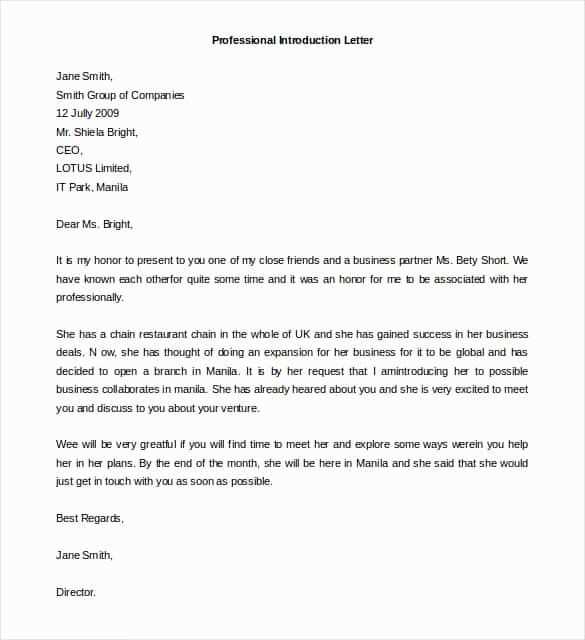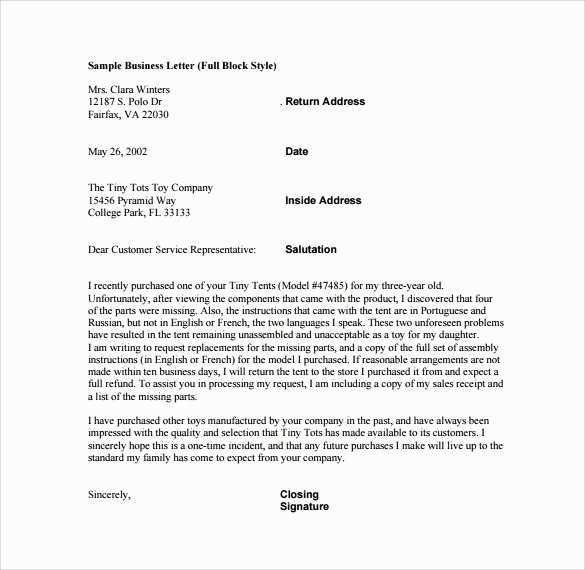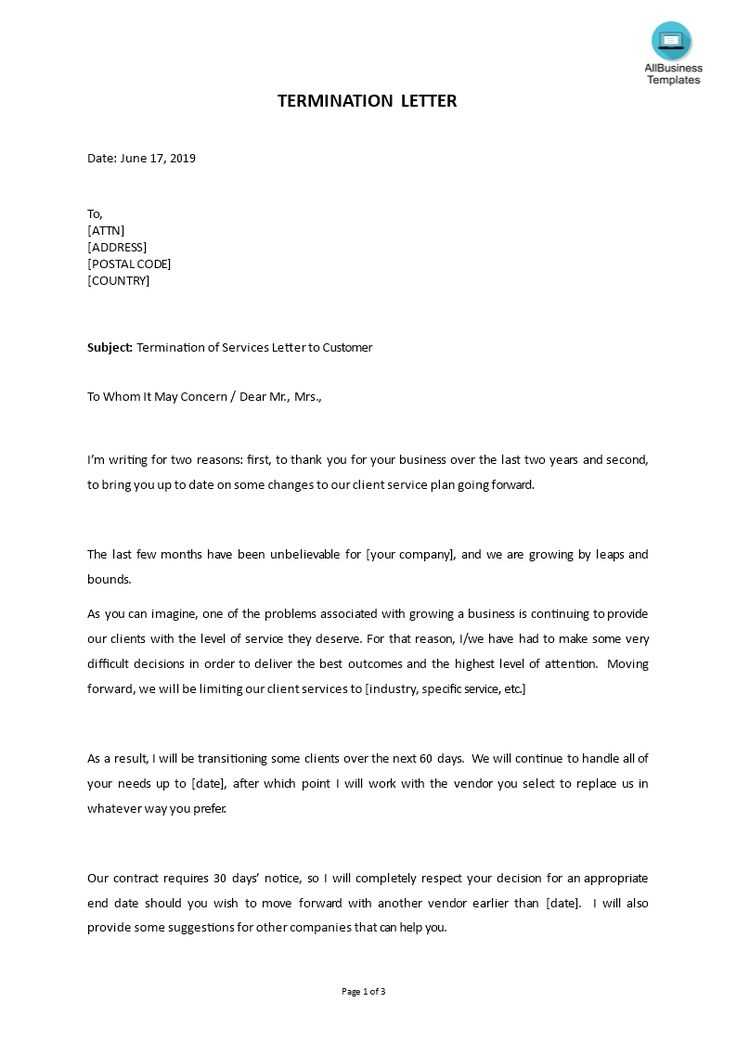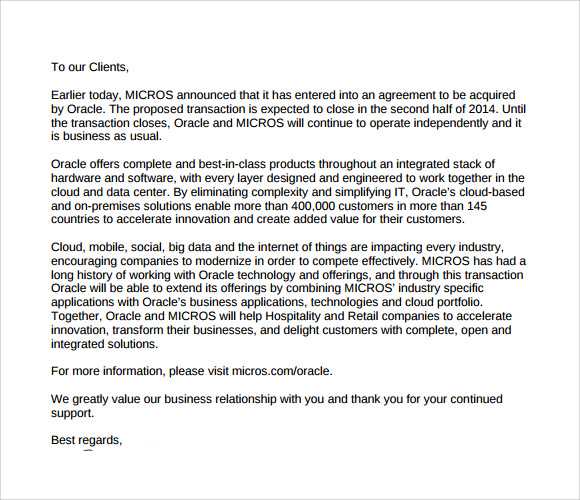Business closing letter to customers templates

Writing a business closing letter is a straightforward task if you focus on clarity and respect for your customers. Begin by directly acknowledging the closure of your business and explaining the timeline for any transitions. Customers appreciate transparency and a clear understanding of what will happen next.
Include specific details about how any outstanding transactions will be handled. Will orders be fulfilled or refunded? Let your customers know the process for returning items or seeking support. A brief explanation of any ongoing support options, such as customer service contacts, can offer reassurance.
Make sure to express genuine gratitude for their loyalty and support during your business’s operation. A heartfelt thank you leaves a positive impression, helping maintain goodwill, even when saying goodbye.
Example Template:
Dear [Customer’s Name],
We regret to inform you that [Company Name] will be closing its doors on [Date]. We want to take a moment to express our heartfelt thanks for your trust and support over the years. We have truly enjoyed serving you.
For any outstanding orders or inquiries, please feel free to contact us at [Customer Service Information] before [Date]. If you need assistance with returns or refunds, we are here to help. Your satisfaction remains a priority until the very end.
Once again, thank you for being part of our community. We wish you all the best in your future endeavors.
Warm regards,
[Your Name]
[Your Title]
[Company Name]
Here are corrected lines without repetition, while preserving meaning and grammatical accuracy:

When notifying your customers about the closure of your business, clarity and directness are key. Use clear language that ensures your message is understood without confusion. Aim to keep sentences concise and avoid redundant phrases that might dilute the message.
Key Tips for Business Closure Notices:

- Start with a straightforward announcement of the closure, specifying the exact date.
- Explain briefly the reason behind the decision, if applicable, without excessive detail.
- Provide alternative contact information or resources if needed after the closure.
- Express gratitude for their support and business over time.
- Reassure them that their current obligations, orders, or payments will be handled professionally.
Focus on providing just the necessary information. Keep the tone polite but firm, ensuring no room for misunderstanding. It’s important to acknowledge the potential inconvenience, but avoid over-explaining or unnecessary apologies.
Example Sentences:
- “We regret to inform you that [Business Name] will be closing on [Date].”
- “We appreciate your patronage over the years and want to ensure a smooth transition.”
- “For any ongoing concerns, please contact us at [Alternative Contact].”
- “All outstanding matters will be resolved before closure to ensure a seamless conclusion.”
Remember, while it’s important to convey the message respectfully, focus on providing the necessary information. Be transparent and provide your customers with the tools to address any questions they may have.
- Business Closing Letter to Customers Templates
When crafting a business closing letter, clarity and sincerity are key. Begin with a straightforward announcement of the closure, providing exact dates and relevant details. Avoid ambiguity to ensure customers understand the change without confusion.
Be direct and transparent: “We are writing to inform you that [Business Name] will be closing on [date].” This simple opening immediately sets the tone, making sure the customer is clear on what’s happening.
Show appreciation: Express gratitude for the support your customers have shown. This could be something like, “We deeply appreciate your trust in us over the years.” This fosters goodwill and helps leave a positive lasting impression.
Address customer concerns: Provide options for how they can address any remaining business or transactions. For example, “If you have any outstanding orders or need assistance, please contact us before [closing date] at [contact information].” Offering clear next steps helps manage any final issues customers might have.
Offer future communication: Even if the business is closing, let customers know if there’s a chance to keep in touch. For instance, “You can follow us on [social media/website] for any updates or future ventures.” This keeps the door open for future connections, even if the business no longer operates in its current form.
Keep it concise: The message should be brief but informative. Avoid unnecessary elaboration or long-winded explanations. Stick to the facts, and ensure the tone matches the relationship you have with the customers.
Close with a positive note: Finish with a simple but warm closing. “We wish you all the best in your future endeavors and hope our paths may cross again.” A positive ending helps smooth over the transition.
Use a straightforward approach when announcing your business closure. Begin with a concise statement that directly addresses the change. Make sure to mention the reason for closure, whether it’s due to external factors, personal reasons, or transitioning to a new phase. Your message should be transparent and without ambiguity.
Offer appreciation for your customers’ support over the years. Acknowledge their loyalty and highlight how their patronage has shaped your business’s story. This not only shows gratitude but also strengthens the relationship, even as you close your doors.
Clearly state the timeline for the closure, including any final business days or deadlines for services or transactions. Ensure that customers are well-informed about how this affects their future interactions with your company.
If applicable, provide guidance on any remaining services or outstanding matters. Direct them to the appropriate resources for questions or to resolve any open issues. This shows that you care about their needs, even after your business has closed.
End the letter on a positive note, offering well wishes for the future. Leave the door open for potential future opportunities or collaborations, so customers know that the closure doesn’t end the relationship entirely.
Address each customer by name to establish a personal connection. This small gesture shows respect and appreciation for their business, making the letter feel more sincere. Instead of using generic phrases, mention their specific interactions with your business or how their loyalty has been valued.
Include Specific Details
Be sure to tailor the letter by referencing any relevant orders or services the customer has used. This demonstrates that you are acknowledging their history with your business and not simply sending a standard message.
Express Gratitude and Offer Alternatives
Convey your gratitude for their support throughout your business’s operation. Additionally, suggest alternatives for future needs, whether it’s another local business or online options, showing that you care about their continued satisfaction.
Personalizing your closure letter leaves customers with a positive impression and ensures that they feel valued, even as your business shuts its doors.
Begin with a direct and clear statement of the business closure. Indicate the date when operations will cease and provide a brief explanation, if necessary, without excessive details. Be transparent but concise.
Outline any final transactions or orders. Let customers know about pending orders or services, and how those will be handled. Mention any refunds or credits they can expect.
Provide contact information for any outstanding concerns. Customers should know how to reach someone for questions or issues that arise post-closure. Offer alternative channels for support if applicable.
Thank customers for their business and express genuine appreciation for their support over the years. Maintain a positive tone that leaves a lasting, favorable impression.
If applicable, inform customers about the transition to other services or businesses. Offer recommendations for where they can find similar services or products if your business has specialized offerings.
Lastly, close with a polite and cordial sign-off. Reassure customers that you value their relationship, even as the business winds down, and leave the door open for potential future contact.
Clearly communicate your refund policies to avoid confusion. Set a specific timeframe for refund requests and provide easy instructions. Let customers know if they need to submit any documents, such as receipts or proof of purchase, and offer an online platform for submitting requests. This reduces the chance of misunderstandings and creates transparency.
Refund Process Example
| Step | Action |
|---|---|
| Step 1 | Customer submits refund request via online portal |
| Step 2 | Verify customer information and purchase details |
| Step 3 | Process refund within specified timeframe (e.g., 7 days) |
| Step 4 | Notify customer of refund confirmation and any next steps |
Make sure to address service continuity for customers who may be affected by your business closure. Inform them of any ongoing support or alternative solutions you offer. If you can provide referrals to similar services, mention them in your communication. Keep customers informed about any changes that could impact their experience, such as account access or product availability.
Service Continuity Information

| Service | Availability |
|---|---|
| Customer Support | Available via email for urgent issues until X date |
| Subscriptions | Suspended, refunds will be processed accordingly |
| Product Availability | Out of stock, alternative suppliers suggested |
Send your closing letter well in advance to give customers time to adjust. Aim for at least two weeks’ notice before the closing date. This allows clients to complete their transactions or seek alternatives if necessary. Timing your letter too late might leave them frustrated or unprepared.
Consider your customer base’s needs. If your business served long-term clients, a longer notice–up to a month–would be appropriate. For more seasonal or one-time buyers, two weeks is usually enough to convey the message effectively.
Ensure you avoid sending the letter during busy periods, such as holidays, when clients may overlook important details. Similarly, refrain from sending it too early, as customers might forget or become confused about the closure date.
Craft your timing based on the nature of your business and customer expectations. Regular clients who expect ongoing services will appreciate more time to adjust their plans. For those who may only use your business occasionally, a shorter notice will suffice.
Once you’ve sent a business closure notification, it’s key to follow up with your customers. This helps maintain transparency and strengthens your relationship, even as your business winds down. Start by reaching out with a clear and concise message acknowledging the receipt of their initial response. This reinforces that their feedback is valued.
Set clear expectations regarding any remaining processes, such as outstanding orders or refunds. Keep them updated about timelines, so there’s no confusion about final steps. If applicable, provide alternative options for any services or products they relied on, or suggest other businesses that can meet their needs.
Responding to questions promptly shows you care, even as the business closes. Use the follow-up as an opportunity to express gratitude for their support and loyalty. Offer a way for customers to stay in touch with your team for any future queries or support, even if you’re no longer operating in the same capacity.
Lastly, ensure your follow-up is as personal as possible, addressing each customer’s specific concerns. A tailored approach enhances their experience and shows your commitment to good service until the end.
Use clear and concise language in your business closing letter to maintain a positive connection with your customers. Focus on expressing gratitude and providing essential details to ensure a smooth transition.
- Thank the customer for their support and trust throughout your business relationship.
- Inform them about the closure date and any actions they need to take, such as using remaining credits or redeeming services.
- Reassure them that all existing commitments will be honored and that you will provide assistance during the transition period.
- Provide contact details for any follow-up questions, ensuring continued customer support during the winding down process.
Keep the tone positive and proactive, addressing any potential concerns upfront. By doing this, you not only maintain trust but also leave the door open for future opportunities if the circumstances change.